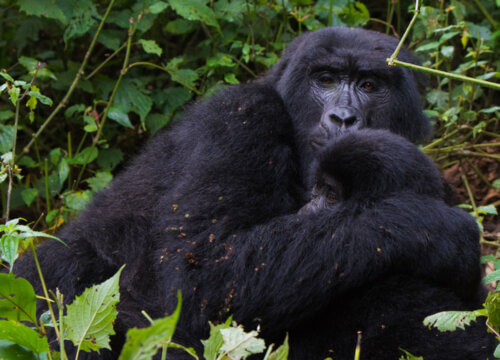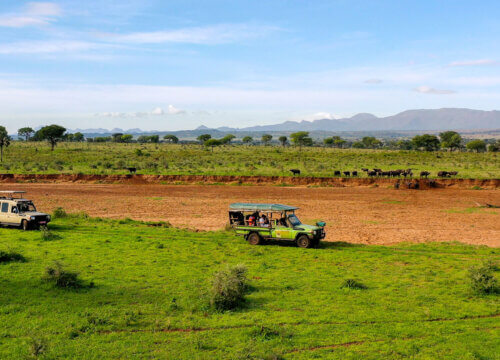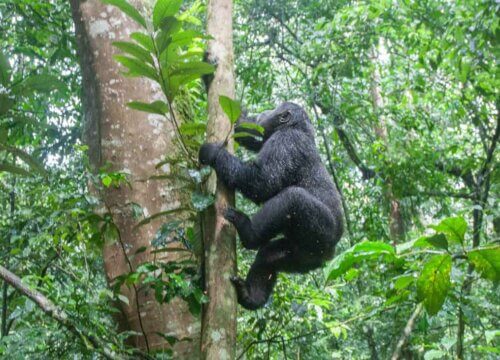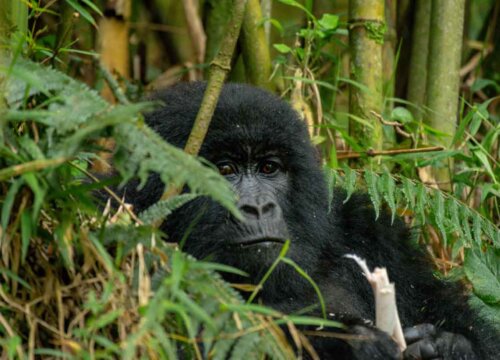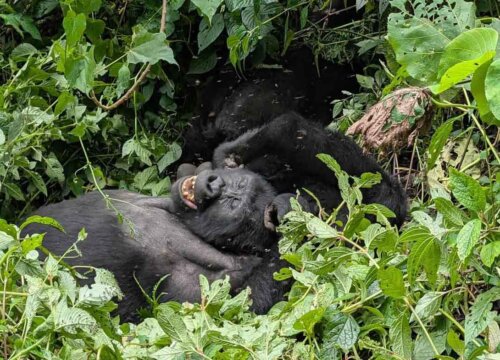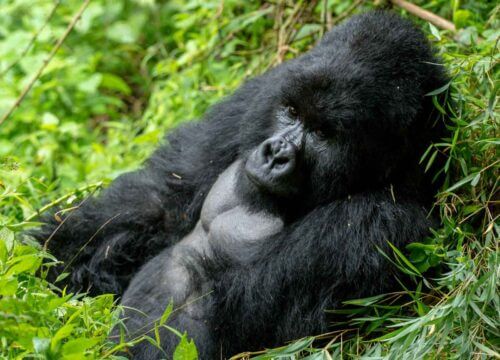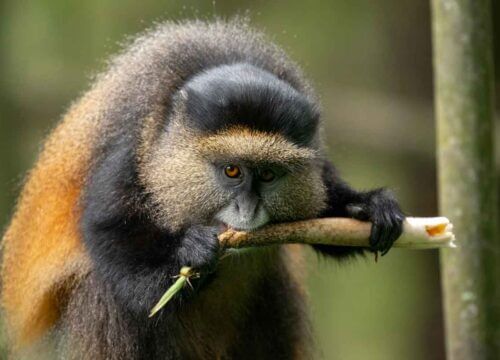Why are chimpanzees in Bwindi Impenetrable National Park not habituated?
Why are chimpanzees in Bwindi Impenetrable National Park not habituated?
Bwindi Impenetrable National Park in Uganda is famous for its rich biodiversity and is home to many captivating species including chimpanzee trekking. However, unlike their counterparts in other parts of Uganda such as Kibale National Park, the chimpanzees in Bwindi Impenetrable National Park are not fully habituated to human presence. This means they are not used to frequent human interactions, making them more challenging to observe. This article gives you reasons why chimpanzees in Bwindi Impenetrable National Park not habituated.
The dense and rugged terrain in Bwindi
Impenetrable National Park’s ground is famously rough with steep hills and thick vegetation. This impenetrable landscape makes it difficult for researchers and guides to follow and track chimpanzees consistently. The dense forest provides ample hiding spots for the chimpanzees, allowing them to avoid human contact more easily than in open or less dense habitats.
Low population density. The chimpanzee population in Bwindi Impenetrable National Park is relatively small compared to other parks like Kibale. With fewer individuals spread across a large area, it becomes harder to locate and interact with them regularly. This limited contact reduces the chances of habituating the chimpanzees over time.
Focusing on gorilla tourism. Bwindi Impenetrable National Park is world-renowned for its mountain gorillas and much of the park’s tourism and conservation efforts are centered around these gentle giants. As a result, there has been less emphasis on habituating chimpanzees with resources and attention directed primarily toward gorilla trekking.
Chimpanzee behavior and adaptability
Chimpanzees are highly intelligent and adaptable animals. In Bwindi Impenetrable National Park, they have learned to associate humans with potential threats or disturbances due to hunting or habitat encroachment in the past. This cautious behavior makes them more likely to avoid humans rather than become habituated.
Historical threats from humans. In earlier decades, chimpanzees in Bwindi Impenetrable National Park faced threats such as poaching and habitat destruction. Although conservation efforts have improved significantly, these past experiences may have left the chimpanzees suspicious of humans. Their natural instinct to avoid potential danger has likely been passed down through generations.
Limited research initiatives. Unlike other parks where extensive research projects have been conducted on chimpanzees, Bwindi Impenetrable National Park has seen fewer long-term studies focused on these primates. Chimpanzee habituation requires consistent effort over time but the lack of dedicated research teams has hindered progress in this area.
Nomadic lifestyle of Chimpanzees. Chimpanzees in Bwindi Impenetrable National Park tend to move frequently in search of food, making it challenging to keep track of them. Their nomadic lifestyle means they do not stay in one area for extended periods, reducing opportunities for consistent human interaction necessary for chimpanzee habituation.
Abundant food sources. Bwindi Impenetrable National Park’s lush forest provides an abundance of food for chimpanzees, allowing them to thrive without needing to venture into areas frequented by humans. This self-sufficiency reduces the likelihood of encounters with people, further limiting the chances of chimpanzee habituation.
Conservation priorities. The park’s primary goal is conservation which sometimes means minimizing human interference with wildlife. While chimpanzee habituation can benefit tourism and research, it also poses risks such as increased stress or exposure to diseases for the animals. In Bwindi Impenetrable National Park, maintaining a natural balance may take precedence over chimpanzee habituation efforts.
Short trekking experiences
Unlike gorilla trekking which often involves longer periods spent observing the animals, chimpanzee tracking in Bwindi is typically shorter and less immersive. This limited interaction time does not allow for the gradual process of building trust between humans and chimpanzees.
Competition among wildlife. Bwindi Impenetrable National Park is home to a diverse range of wildlife including elephants, monkeys and various bird species. This competition for space and resources can influence chimpanzee behavior, making them more isolated and less inclined to interact with humans.
Cultural practices and beliefs
In some local communities surrounding Bwindi Impenetrable National Park, traditional beliefs about chimpanzees may have influenced how people interact with them historically. Fear or reverence for these primates could have contributed to a lack of early chimpanzee habituation efforts, leaving the chimpanzees more isolated from human activity.
What is chimpanzee habituation?
Chimpanzee habituation is the process of gradually getting wild chimpanzees accustomed to the presence of humans without altering their natural behavior. This practice is often carried out by researchers, conservationists and wildlife enthusiasts who aim to study or protect chimpanzees in their natural habitats. The process involves spending extended periods of time near chimpanzee groups while maintaining a respectful distance. Over time, the chimpanzees begin to see humans as non-threatening and go about their daily activities like foraging, grooming or playing without fear or stress. This allows researchers to observe their behavior, social structures and interactions more closely.
Chimpanzee trekking permits in Bwindi Impenetrable National Park
Chimpanzee trekking permits are essential for anyone wanting to join a trek to see these primates in their natural habitat. These chimpanzee trekking permits are issued by the Uganda Wildlife Authority (UWA) and are designed to regulate the number of visitors, ensuring minimal impact on the environment and the well-being of the chimpanzees. The Chimpanzee trekking process is straightforward but permits can sell out quickly due to high demand, so it is best to plan ahead by booking your permit with Giant Holiday Safaris in advance. The cost of a chimpanzee trekking permit in Uganda is generally more affordable compared to gorilla trekking permits. While Chimpanzee trekking permit costs may vary depending on the season, they usually range between $100 and $250 per person.
The permit allows you to spend about an hour observing the chimpanzees after you have tracked them with the help of experienced guides and trackers. To secure your Chimpanzee trekking permit, you can book directly through the Uganda Wildlife Authority or work with Giant Holiday Safaris, a trusted tour company that handles all the arrangements for you. Keep in mind that Bwindi Impenetrable National Park is divided into different sectors, so your Chimpanzee trekking permit will specify the area where your trek will take place. Make sure to double-check this detail when planning your itinerary.
Best time to visit Bwindi Impenetrable National Park for Chimpanzee trekking
The best time to visit Bwindi Impenetrable National Park for Chimpanzee trekking is during the dry season which occurs from June to September and December to February. During this time, rainfall is minimal resulting in drier trails and more manageable trekking conditions. Bwindi’s rugged terrain can be challenging to navigate especially during the rainy season when trails become muddy and slippery. The dry season ensures safer and more comfortable hiking, making it easier for visitors to focus on the incredible wildlife around them. The reduced rainfall during the dry season leads to less dense vegetation, improving visibility within the forest. This makes it easier to spot chimpanzees and other wildlife as they move through their natural habitat. Additionally, the drier weather encourages chimpanzees to remain active and spend more time in open areas, increasing the likelihood of close encounters. The dry season also ensures smoother travel to and from the park, reducing delays and enhancing the overall experience for visitors.
For photographers, the dry season offers ideal lighting conditions and clearer skies. The reduced humidity minimizes fog and haze, allowing for crisp and vibrant photographs.
Chimpanzees are highly social animals that tend to gather in groups during the dry season as food sources become more concentrated. This increases the chances of observing their interactions, behaviors and vocalizations up close. The dry season also coincides with periods when fruiting trees are abundant, attracting chimpanzees to specific areas of the forest, making them easier to locate.
What to carry for chimpanzee trekking in Bwindi Impenetrable National Park
Carry a sturdy pair of hiking boots crucial for navigating Bwindi Impenetrable National park’s rugged and sometimes muddy terrain. Make sure they are well broken-in to avoid blisters and provide the grip you need for steep trails.
Bwindi Impenetrable National Park’s rainforest climate means sudden rain showers are common. Pack a lightweight, waterproof jacket to keep you dry without adding unnecessary weight to your pack.
Carry long-sleeved shirts and trousers that are essential for protecting your skin from insect bites, thorny plants and the sun. opt for breathable, quick-dry materials for added comfort.
Carry a good insect repellent with DEET to keep pesky bites at bay during your trek because the forest is home to many insects including mosquitoes.
Pack a small, comfortable backpack essential for carrying your water, snacks and other essentials. Look for one with multiple compartments for easy organization.
Hydration is key during chimpanzee trekking, so bring a reusable water bottle to stay refreshed. Consider carrying a water purification method if you are unsure about water sources.
Pack some high-energy snacks or bars to keep your energy levels up throughout the day.
Packing binoculars can enhance your experience by allowing you to observe birds and other wildlife from a distance.
Pack a camera or smartphone to capture the incredible moments of your trek. Do not forget extra batteries or a power bank to ensure you do not miss a thing.
Protect yourself from the sun by coming with a wide-brimmed hat. It will shield your face and neck while keeping you cool on sunny days.
Carry sunscreen and lip balm. Even in the forest, UV rays can penetrate through the canopy. Apply sunscreen and carry lip balm with SPF to prevent sunburn and chapped lips.
Pack lightweight gloves to protect your hands when grabbing onto branches or trekking poles especially in areas with dense vegetation.
Carry trekking poles to provide extra stability on uneven terrain and help reduce strain on your knees during steep ascents or descents.
Carry a basic first aid kit with items like band-aids, antiseptic wipes, pain relievers and any personal medications you might need.
It is always great to have some Ugandan shillings for tipping guides or purchasing souvenirs at nearby markets after chimpanzee trekking.
For more information about chimpanzee trekking in Bwindi Impenetrable National Park, contact Giant Holiday Safaris.
Explorer More Safaris
- 14-Days Uganda Safari Gorilla Chimpanzees and Wildlife
- 12 Days Gorillas and Chimpanzees Wildlife Safari
- 10 days best of uganda primates & wildlife safari
- 6 Days Gorillas and Chimpanzee Trekking Safari
- 3 Day Bwindi Gorilla Trekking Safari
- 4 Day Uganda Gorilla Trekking and Wildlife Safari
- 4 Days Gorilla Trekking and Adventure Safari
- 5 Days Uganda Gorillas and Chimpanzee Tracking Safari
- 4-Day Rwanda Gorilla Trekking and Golden Monkey Tracking Safari
- 5 Day Gorilla Habituation and Chimp Trekking
- 4-Day Uganda & Rwanda Gorilla Trekking Tour
- 3 Days Bwindi Gorilla Trekking Ugnada from Rwanda
- 10 Days Uganda Primates and Game Safari

